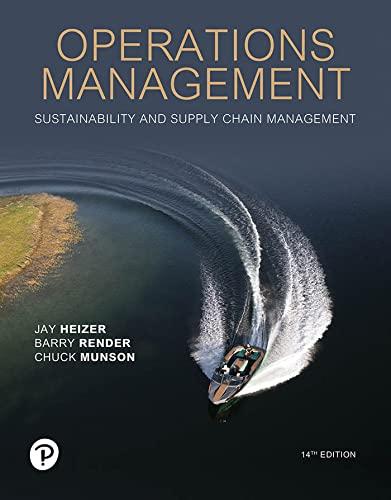Darden Restaurants, owner of popular brands such as Olive Garden, Bahama Breeze, Seasons 52, and LongHorn Steakhouse,
Question:
Darden Restaurants, owner of popular brands such as Olive Garden, Bahama Breeze, Seasons 52, and LongHorn Steakhouse, requires unique supply chains to serve hundreds of millions of meals annually. Darden’s strategy is operations excellence, and Senior VP Jim Lawrence’s task is to ensure competitive advantage via Darden’s supply chains. For a firm with purchases exceeding $1.8 billion from 1,500 suppliers, managing the supply chains is a complex and challenging task. Darden, like other casual dining restaurants, has unique supply chains that reflect its menu options. Darden’s supply chains are rather shallow, often having just one tier of suppliers. But it has four distinct supply chains. First, “smallware” is a restaurant industry term for items such as linens, dishes, tableware and kitchenware, and silverware. These are purchased, with Darden taking title as they are received at the Darden Direct Distribution (DDD) warehouse in Orlando, Florida. From this single warehouse, smallware items are shipped via common carrier (trucking companies) to Olive Garden, Bahama Breeze, and Seasons 52 restaurants. Second, frozen, dry, and canned food products are handled economically by Darden’s 11 distribution centers in North America, which are managed by major U.S. food distributors, such as MBM, Maines, and Sygma. This is Darden’s second supply line. Third, the fresh food supply chain (not frozen and not canned), where product life is measured in days, includes dairy products, produce, and meat. This supply chain is B2B, where restaurant managers directly place orders with a preselected group of independent suppliers. Fourth, Darden’s worldwide seafood supply chain is the final link. Here Darden has developed independent suppliers of salmon, shrimp, tilapia, scallops, and other fresh fish that are source inspected by Darden’s overseas representatives to ensure quality. These fresh products are flown to the U.S. and shipped to 16 distributors, with 22 locations, for quick delivery to the restaurants. With suppliers in 35 countries, Darden must be on the cutting edge when it comes to collaboration, partnering, communication, and food safety. It does this with heavy travel schedules for purchasing and quality control personnel, native speaking employees on site, and aggressive communication. Communication is a critical element; Darden tries to develop as much forecasting transparency as possible. “Point of sale (POS) terminals,” says Lawrence, “feed actual sales every night to suppliers.”
Discussion Questions
1. What are the advantages of each of Darden’s four supply chains?
2. What are the complications of having four supply chains?
3. Where would you expect ownership/title to change in each of Darden’s four supply chains?
4. How do Darden’s four supply chains compare with those of other firms, such as Dell or an automobile manufacturer? Why do the differences exist, and how are they addressed?
Step by Step Answer:

Operations Management Sustainability And Supply Chain Management
ISBN: 9780137476442
14th Edition
Authors: Jay Heizer, Barry Render, Chuck Munson





